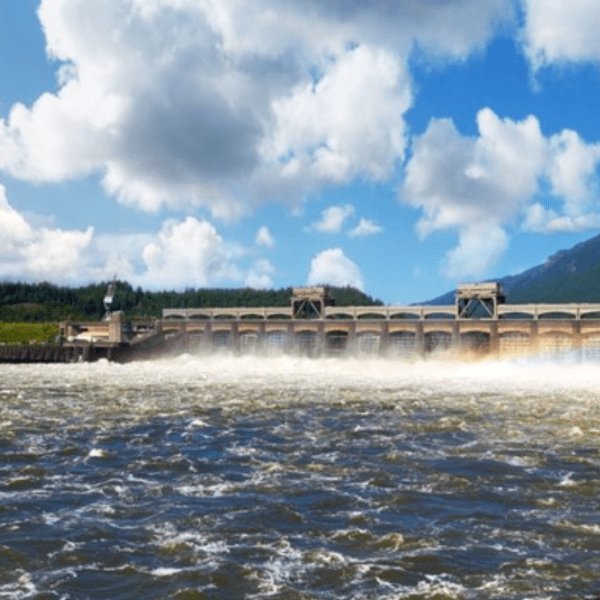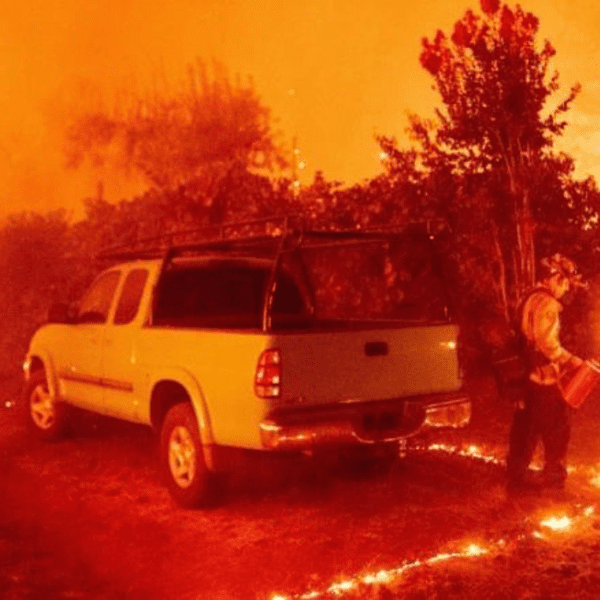On September 2nd, 2022, just two days after Starbucks ushered in fall with its seasonal pumpkin spiced latte, the hottest September day on Earth was recorded in California’s Death Valley. With an air temperature of up to 127 degrees Fahrenheit and a ground temperature hot enough to cook an egg, the national park cracked previously standing global heat records for the month. The record temperature was part of a major heat wave that swept the west for 12 days and was described by California Governor Gavin Newsom as “the hottest and longest on record.”
HYDROPOWER IS THE WEST’S LEADING RENEWABLE ENERGY SOURCE, EVEN IN DROUGHT
In spite of the increased demand on regional electric grids as people ramped up their air conditioners, rolling blackouts across western states were avoided in part through strategic text messages sent out at times of peak demand asking folks to curtail their electricity usage. But credit for keeping the lights on (and air conditioning running) is also due to the West’s hydropower resources, which were able to balance the grid in evening hours of peak demand when solar power went offline.
“While the predominant media narrative has been sowing seeds of doubt about hydropower’s reliability as the West continues to face historic drought, data shared by the U.S. Energy Information Administration tells a different story.”
Over the course of the heat wave, hydropower in the northwest region (which includes Oregon, Washington, Idaho, Wyoming, Montana, northern Nevada, Utah, and Colorado) continued to far outpace other renewable energy sources across western states, delivering 26% of total electricity generated, and demonstrating that even with reduced water levels due to drought, hydropower remains a cornerstone of the existing grid and a necessary building block for the transition to a low-carbon grid.
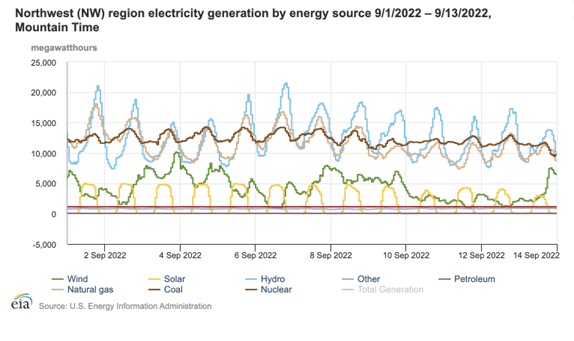
IS HYDROPOWER AT RISK AS HEAT WAVES INTENSIFY AND DROUGHT DEEPENS?
Even as we reflect on hydro’s role as a baseline power source for the grid, the question of how hydropower will fare if we face the compounding effects of multiple heatwaves and ongoing drought still lingers. A recent report from Pacific Northwest National Laboratory (PNNL) explores this question, noting that how drought affects individual hydropower plants can vary substantially, based on the specific conditions of a plant and its location. Because hydro plants — even in the same large basin like the Columbia River — experience differing climatic conditions, PNNL researchers note that, “in the last 20 years there has not been a drought that has affected all major hydro generation regions at once.” This means that while one area may face low water levels that temporarily reduce hydropower production, other plants can be resourced to make up for this shortfall, underscoring the collective dependability of hydropower.

A rainbow forms downstream of Bonneville Dam on the Columbia River, image courtesy of David Gn, Adobe Stock
With this in mind, as policymakers and planners look to plan the future of the electric grid, hydropower should still be viewed as a massive and reliable energy source that is foundational to a low-carbon grid. In fact, a Royal Bank of Canada analysis of how Canada can build out a net-zero grid by 2035 calls hydropower “Canada’s trump card:” a reliable, emissions-free, baseload energy source that can back up wind and solar. The report notes that “excluding hydro projects from the grid…risks eliminating a cost-effective sustainable source in the long run.”
CLIMATE CHANGE IS WATER CHANGE
Acknowledging that hydropower is, and should remain, a pillar of the clean energy transition does not mean simply carrying on with business as usual. While climate models differ on the predicted frequency of droughts or periods of increased precipitation, it is clear that climate change is water change, and we must adopt new strategies to ensure that the hydropower of the future is responsive and resilient in the face of an evolving climate.
For each degree of atmospheric warming, air can hold more moisture (about 7 percent more per 1.8°F (1°C) of warming). This rise in atmospheric moisture levels has triggered some of the dramatic precipitation events we’ve seen recently across the United States that have resulted in four 1000-year floods this summer alone. A warmer atmosphere also contributes to an overall trend of declining snowpack, like what continues to play out in the American West where spring snowpack has declined by nearly 20 percent on average between 1955 and 2020. What’s more, as snowpack declines, the variability of river flows increases as rivers lose a once-steady supply of water from spring and summer snowmelt.
LEARNING FROM NATURE’S ENGINEERS TO OPTIMIZE HYDROPOWER
Armed with knowledge about how the water cycle is changing, we can take necessary steps to ensure hydropower is part of the solution to mitigate climate change — not just from a carbon-reduction standpoint, but also as a tool for driving landscape-scale adaptation. As we work to retrofit aging hydro infrastructure and to assess and build new hydro projects we can borrow strategies from one of the world’s most successful engineers — the beaver.
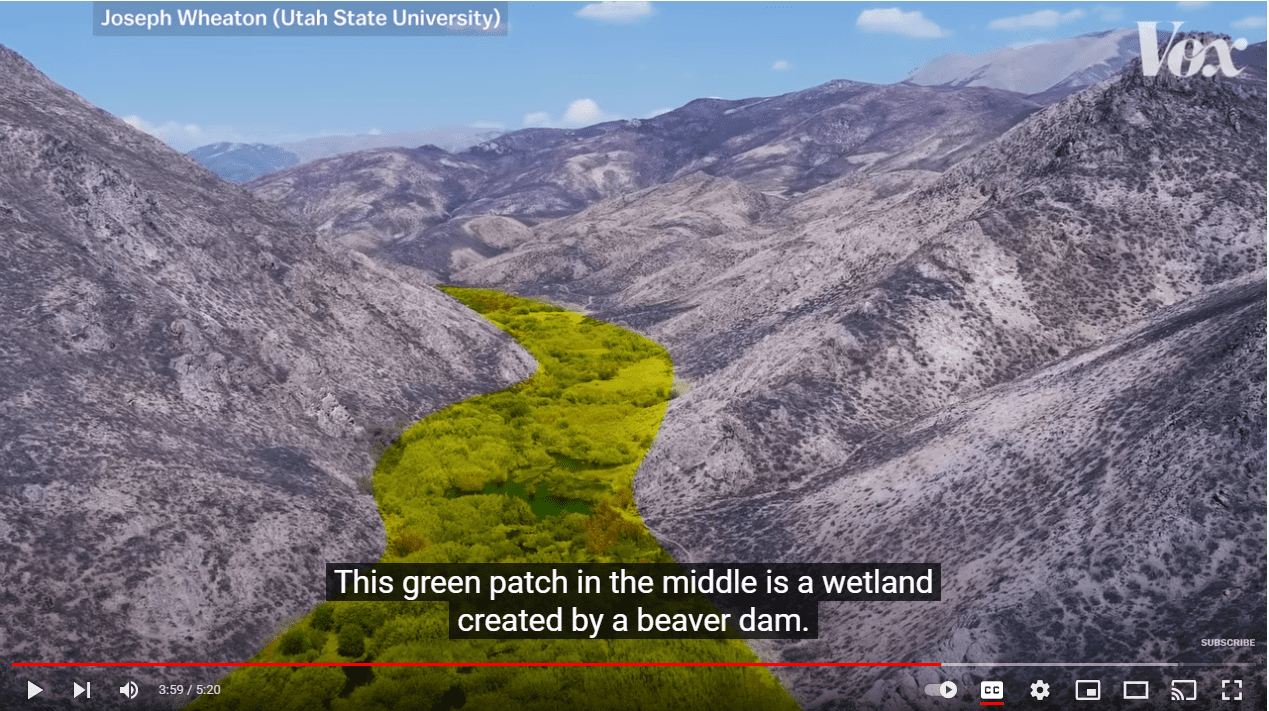
A recent video from Vox explains how beavers improve the resilience of landscapes facing drought and wildfire.
A growing body of scientific research points to the efficacy of mimicking the water management strategies of beavers to mitigate drought, restore floodplains, re-establish wetlands, replenish groundwater, and protect basins from wildfire, all while creating richly biodiverse habitat. Western states are already embracing the benefits of beavers with programs to reintroduce the animals and to create beaver dam-like structures that are functionally similar.
Natel Energy created an approach called Restoration Hydro that couples civil engineering techniques drawn from beavers with hydropower development to take advantage of the same restoration benefits that beaver dams provide, while also generating reliable renewable energy.
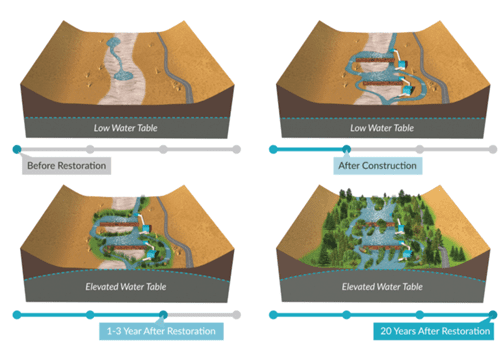
Natel Energy’s Restoration Hydro approach to project development couples hydropower with civil engineering techniques inspired by beavers to increase climate resilience.
BUILDING THE WATER INFRASTRUCTURE OF THE FUTURE
Restoration Hydro is not as much of a departure from conventional practices as it may seem. Already, according to data from Oak Ridge National Laboratory, the majority of the Northwest’s hydro plants (which supplies much of the rest of the western United States with power) are run-of-river plants, or other small, distributed plants, collectively producing over 23,000 MW. It is still a leap to modify our existing hydropower fleet to incorporate natural infrastructure, but this is a challenge we must undertake to ensure hydropower’s lasting resiliency.
To truly help transform our water infrastructure while also meeting our energy needs, we need to develop run-of-river hydro strategies that employ green infrastructure and strike a balance between the massive scale of plants like Bonneville Lock and Dam on the Columbia River and a small beaver dam.
In Australia, stakeholder groups are already coming together to reimagine the water infrastructure of the continent’s third-largest river, the Murrumbidgee. Their strategy to address environmental and human health risks associated with drought applies a lens of three infrastructures: ‘grey’ (built), ‘green’ (natural), and ‘soft’ (governance). As water futures researchers Paul Wyrwoll and Quentin Grafton write, “We need a new paradigm for how we manage water, a rethinking where human societies work with and nurture the hydrological cycle, instead of trying to master it.”
A LEADING RENEWABLE ENERGY SOURCE FOR THE PLANET
Looking ahead to the rest of what the West now calls “fire season,” it is clear that the effects of climate change are ongoing. Nonetheless, through these extreme and varied weather conditions, hydropower remains a critical means to a stable grid. What’s more, when thoughtfully deployed in tandem with natural infrastructure, hydro soars well above many other renewables as a leading solution for building a resilient future.








